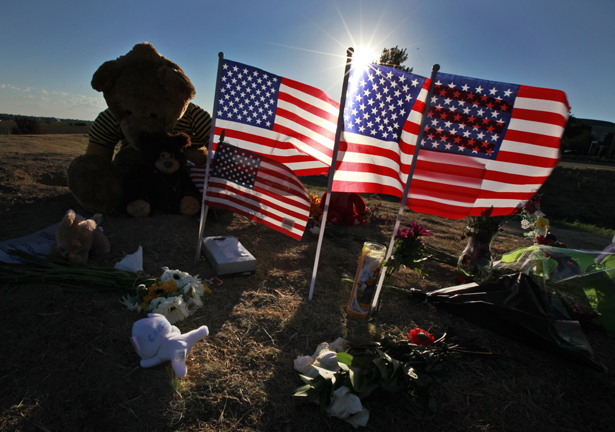
The sun rises between flags placed at a memorial near the the Century 16 movie theater Sunday, July 22, 2012, in Aurora, Colorado. (AP Photo/Alex Brandon)
The only thing more predictable than a mass shooting in America is the alacrity with which the nation’s political class will declare itself shocked and the media class—which has well-rehearsed contingencies for just such occasions—will faithfully transmit and amplify that shock to the nation.
"America leads the world in shocks," noted the late singer Gil Scott-Heron in "We Beg Your Pardon." "Unfortunately, America does not lead the world in deciphering the cause of shock."
And so it was that when the news emerged that a lone gunman had sprayed a cinema with gunfire in Aurora, the incident was described as "unimaginable," "incredible" and "unfathomable." However else one would describe events in Colorado in the early hours of that Friday morning, they were hardly unimaginable. Columbine is less than a forty-minute drive away. Just a few days earlier a man shot up a bar in Tuscaloosa, Alabama, wounding seventeen people. While Aurora’s tragedy was certainly abhorrent, it was by no means aberrant.
For the injured and bereaved such shootings are harrowing and startling. But although the venue, timing and scale of these tragedies may differ along with their dramatic idiosyncrasies—trench coats in Columbine, Batman in Aurora, Tea Party talking points in Tucson—the fact that they will happen is a wretched yet constant feature of American life.
Nor does it take any great powers of analysis to work out why they happen. There are roughly ninety guns for every 100 people in America (by far the highest concentration in the world, with Yemen a distant second at fifty-five), and roughly eighty-five people are killed by guns here every day.
Those two facts are not necessarily causally linked. Incidences of hypothermia and burst water pipes both rise in the winter. They’re connected by the season. But that doesn’t mean people come down with hypothermia because of burst water pipes or pipes burst as a result of people’s deteriorating health. Similarly, access to guns does not, by itself, lead to gun crime. Sweden, Finland and Switzerland are also in the top ten for gun ownership per capita, but none of them have a high rate of gun homicides. So while it is certainly true that more guns increase the possibility of mass shootings (James Holmes bought his arsenal legally—had it been more difficult, his rampage might have been checked), they don’t by themselves increase the likelihood.
What links America’s high concentration of guns and relatively high level of gun deaths are the country’s high levels of inequality, segregation and poverty. For in countries with at least two of those features—South Africa, Honduras, El Salvador, Jamaica, Guatemala—you will find higher levels of gun deaths.
Popular
"swipe left below to view more authors"Swipe →
There are many poor, unequal and segregated countries that don’t have a big problem with gun violence; and there are many countries with lots of guns that do not have a big problem with gun violence. But America is the only place in the Western world that has both rampant inequality and ample access to guns. Add to that a healthcare system in which large numbers of people are deprived of the mental health facilities they need, and you have laboratory conditions for sustained outbreaks of social violence involving guns.
The precise series of events, rationalizations and explanations for how each person makes the decision to go out and shoot one or several people is particular to the person, time and place. But the notion that all these incidents are not part of a pattern is untenable. When large numbers of guns are available in a society with massive inequalities, the likelihood is that a lot of people are going to get shot.
There is nothing inevitable about this. Polls show a narrow majority believes both gun laws and laws covering the sale of firearms should be stricter. That support has ebbed in recent years and lacks electoral expression and political capacity. But given that mainstream politicians have abandoned the cause, the constituency remains remarkably robust. What is lacking are leaders prepared to mobilize those numbers at the ballot box to confront the financial and lobbying might of the National Rifle Association.
So given the regularity and predictability of these calamities, why the recurrent shock? It seems that assumptions about the perpetrators of gun violence, their motivations and their victims are in constant need of being reset. If Holmes had been Muslim, we would now be talking about radical Islam; if he was undocumented, we would be talking about electrifying a 2,000-mile fence; if he was black, we’d be talking about the consequences of affirmative action in PhD programs. But in the absence of a sweeping and unfounded anxiety about white people or a political conversation about gun control or inequality, we end up talking about good and evil. Without context, these things truly are unfathomable.
Moreover, there are some places in America where you are supposed to be safe—shopping malls, suburban schools, cinemas—and there are other places where people are expected to be vulnerable: poor black and Latino neighborhoods. The possibility of arbitrary death, like systemic incarceration, is just understood to be the price you pay for being black or Latino in America. On the night after the shooting in Aurora, twenty-two people were shot, three fatally, in Chicago. But when the chaos of the hood intrudes on the security of suburbia, a moment of collective cognitive dissonance occurs.
The shock resides not in the fact that a large number of people have been killed by a gunman—that happens every night in America—but that every now and then, the wrong people have died in the wrong place.


